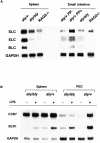Alymphoplasia (aly)-type nuclear factor kappaB-inducing kinase (NIK) causes defects in secondary lymphoid tissue chemokine receptor signaling and homing of peritoneal cells to the gut-associated lymphatic tissue system
- PMID: 10790423
- PMCID: PMC2213441
- DOI: 10.1084/jem.191.9.1477
Alymphoplasia (aly)-type nuclear factor kappaB-inducing kinase (NIK) causes defects in secondary lymphoid tissue chemokine receptor signaling and homing of peritoneal cells to the gut-associated lymphatic tissue system
Abstract
Alymphoplasia (aly) mice, which carry a point mutation in the nuclear factor kappaB-inducing kinase (NIK) gene, are characterized by the systemic absence of lymph nodes and Peyer's patches, disorganized splenic and thymic architectures, and immunodeficiency. Another unique feature of aly/aly mice is that their peritoneal cavity contains more B1 cells than normal and aly/+ mice. Transfer experiments of peritoneal lymphocytes from aly/aly mice into recombination activating gene (RAG)-2(-/-) mice revealed that B and T cells fail to migrate to other lymphoid tissues, particularly to the gut-associated lymphatic tissue system. In vivo homing defects of aly/aly peritoneal cells correlated with reduction of their in vitro chemotactic responses to secondary lymphoid tissue chemokine (SLC) and B lymphocyte chemoattractant (BLC). The migration defect of aly/aly lymphocytes was not due to a lack of expression of chemokines and their receptors, but rather to impaired signal transduction downstream of the receptors for SLC, indicating that NIK is involved in the chemokine signaling pathway known to couple only with G proteins. The results showed that the reduced serum levels of immunoglobulins (Igs) and the absence of class switch to IgA in aly/aly mice are due, at least in part, to a migration defect of lymphocytes to the proper microenvironment where B cells proliferate and differentiate into Ig-producing cells.
Figures








Similar articles
-
The donor splice site mutation in NFkappaB-inducing kinase of alymphoplasia (aly/aly) mice.Immunogenetics. 2003 Jan;54(10):693-8. doi: 10.1007/s00251-002-0517-x. Epub 2002 Dec 3. Immunogenetics. 2003. PMID: 12557055
-
Alymphoplasia is caused by a point mutation in the mouse gene encoding Nf-kappa b-inducing kinase.Nat Genet. 1999 May;22(1):74-7. doi: 10.1038/8780. Nat Genet. 1999. PMID: 10319865
-
Defects of somatic hypermutation and class switching in alymphoplasia (aly) mutant mice.Int Immunol. 1996 Jul;8(7):1067-75. doi: 10.1093/intimm/8.7.1067. Int Immunol. 1996. PMID: 8757952
-
Regulation of secondary lymphoid organ development by the nuclear factor-kappaB signal transduction pathway.Immunol Rev. 2003 Oct;195:91-105. doi: 10.1034/j.1600-065x.2003.00064.x. Immunol Rev. 2003. PMID: 12969313 Review.
-
Generation, expansion, migration and activation of mouse B1 cells.Immunol Rev. 2000 Aug;176:205-15. doi: 10.1034/j.1600-065x.2000.00604.x. Immunol Rev. 2000. PMID: 11043779 Review.
Cited by
-
Regulation of late B cell differentiation by intrinsic IKKalpha-dependent signals.Proc Natl Acad Sci U S A. 2007 Apr 10;104(15):6359-64. doi: 10.1073/pnas.0700296104. Epub 2007 Apr 2. Proc Natl Acad Sci U S A. 2007. PMID: 17404218 Free PMC article.
-
The donor splice site mutation in NFkappaB-inducing kinase of alymphoplasia (aly/aly) mice.Immunogenetics. 2003 Jan;54(10):693-8. doi: 10.1007/s00251-002-0517-x. Epub 2002 Dec 3. Immunogenetics. 2003. PMID: 12557055
-
A cell-intrinsic requirement for NF-κB-inducing kinase in CD4 and CD8 T cell memory.J Immunol. 2013 Oct 1;191(7):3663-72. doi: 10.4049/jimmunol.1301328. Epub 2013 Sep 4. J Immunol. 2013. PMID: 24006459 Free PMC article.
-
The NFκB signaling system in the generation of B-cell subsets: from germinal center B cells to memory B cells and plasma cells.Front Immunol. 2023 Dec 11;14:1185597. doi: 10.3389/fimmu.2023.1185597. eCollection 2023. Front Immunol. 2023. PMID: 38169968 Free PMC article. Review.
-
Mouse hepatocyte overexpression of NF-κB-inducing kinase (NIK) triggers fatal macrophage-dependent liver injury and fibrosis.Hepatology. 2014 Dec;60(6):2065-76. doi: 10.1002/hep.27348. Epub 2014 Oct 29. Hepatology. 2014. PMID: 25088600 Free PMC article.
References
-
- De Togni P., Goellner J., Ruddle N.H., Streeter P.R., Fick A., Mariathasan S., Smith S.C., Carlson R., Shornick L.P., Strauss-Schoenberger J. Abnormal development of peripheral lymphoid organs in mice deficient in lymphotoxin. Science. 1994;264:703–707. - PubMed
-
- Banks T.A., Rouse B.T., Kerley M.K., Blair P.J., Godfrey V.L., Kuklin N.A., Bouley D.M., Thomas J., Kanangat S., Mucenski M.L. Lymphotoxin-α-deficient mice. Effects on secondary lymphoid organ development and humoral immune responsiveness. J. Immunol. 1995;155:1685–1693. - PubMed
-
- Koni P.A., Sacca R., Lawton P., Browning J.L., Ruddle N.H., Flavell R.A. Distinct roles in lymphoid organogenesis for lymphotoxins α and β revealed in lymphotoxin β-deficient mice. Immunity. 1997;6:491–500. - PubMed
-
- Mauri D.N., Ebner R., Montgomery R.I., Kochel K.D., Cheung T.C., Yu G.L., Ruben S., Murphy M., Eisenberg R.J., Cohen G.H. LIGHT, a new member of the TNF superfamily, and lymphotoxin α are ligands for herpesvirus entry mediator. Immunity. 1998;8:21–30. - PubMed
-
- Pasparakis M., Alexopoulou L., Episkopou V., Kollias G. Immune and inflammatory responses in TNF alpha–deficient micea critical requirement for TNF alpha in the formation of primary B cell follicles, follicular dendritic cell networks and germinal centers, and in the maturation of the humoral immune response. J. Exp. Med. 1996;184:1397–1411. - PMC - PubMed
Publication types
MeSH terms
Substances
LinkOut - more resources
Full Text Sources
Other Literature Sources
Molecular Biology Databases
Miscellaneous

